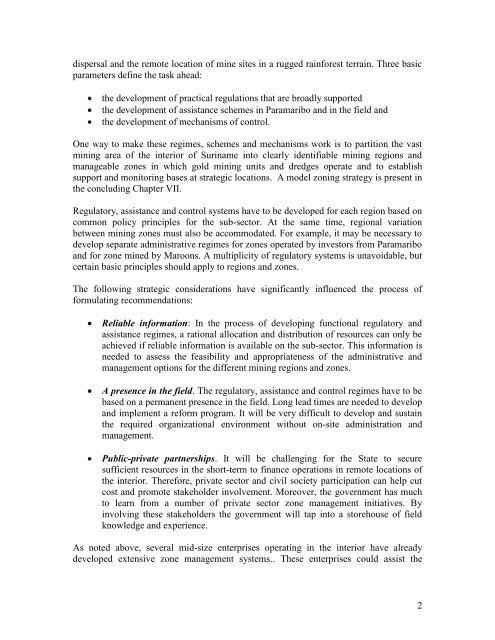SITUATION ANALYSIS OF THE SMALL-SCALE GOLD ... - WWF
SITUATION ANALYSIS OF THE SMALL-SCALE GOLD ... - WWF
SITUATION ANALYSIS OF THE SMALL-SCALE GOLD ... - WWF
Create successful ePaper yourself
Turn your PDF publications into a flip-book with our unique Google optimized e-Paper software.
dispersal and the remote location of mine sites in a rugged rainforest terrain. Three basic<br />
parameters define the task ahead:<br />
the development of practical regulations that are broadly supported<br />
the development of assistance schemes in Paramaribo and in the field and<br />
the development of mechanisms of control.<br />
One way to make these regimes, schemes and mechanisms work is to partition the vast<br />
mining area of the interior of Suriname into clearly identifiable mining regions and<br />
manageable zones in which gold mining units and dredges operate and to establish<br />
support and monitoring bases at strategic locations. A model zoning strategy is present in<br />
the concluding Chapter VII.<br />
Regulatory, assistance and control systems have to be developed for each region based on<br />
common policy principles for the sub-sector. At the same time, regional variation<br />
between mining zones must also be accommodated. For example, it may be necessary to<br />
develop separate administrative regimes for zones operated by investors from Paramaribo<br />
and for zone mined by Maroons. A multiplicity of regulatory systems is unavoidable, but<br />
certain basic principles should apply to regions and zones.<br />
The following strategic considerations have significantly influenced the process of<br />
formulating recommendations:<br />
Reliable information: In the process of developing functional regulatory and<br />
assistance regimes, a rational allocation and distribution of resources can only be<br />
achieved if reliable information is available on the sub-sector. This information is<br />
needed to assess the feasibility and appropriateness of the administrative and<br />
management options for the different mining regions and zones.<br />
A presence in the field. The regulatory, assistance and control regimes have to be<br />
based on a permanent presence in the field. Long lead times are needed to develop<br />
and implement a reform program. It will be very difficult to develop and sustain<br />
the required organizational environment without on-site administration and<br />
management.<br />
Public-private partnerships. It will be challenging for the State to secure<br />
sufficient resources in the short-term to finance operations in remote locations of<br />
the interior. Therefore, private sector and civil society participation can help cut<br />
cost and promote stakeholder involvement. Moreover, the government has much<br />
to learn from a number of private sector zone management initiatives. By<br />
involving these stakeholders the government will tap into a storehouse of field<br />
knowledge and experience.<br />
As noted above, several mid-size enterprises operating in the interior have already<br />
developed extensive zone management systems.. These enterprises could assist the<br />
2
















